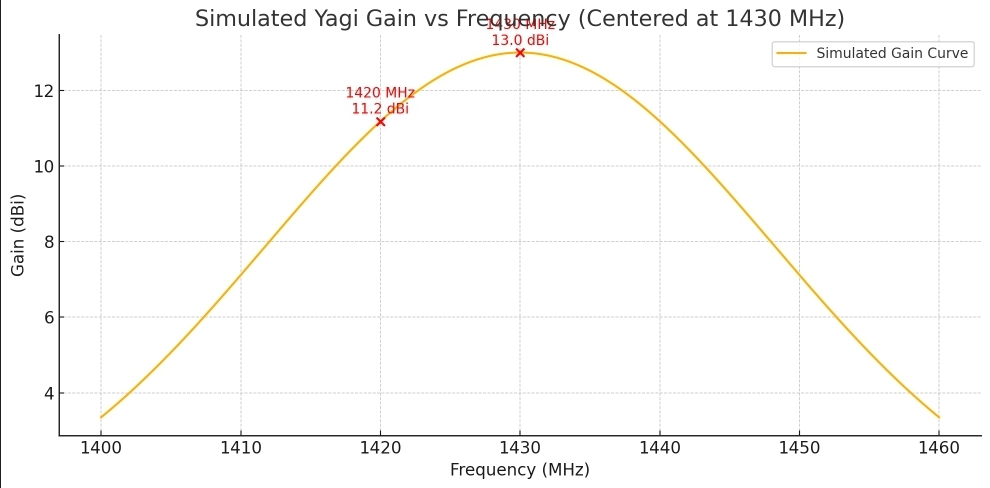Using long Yagi antenna tuned for 1430 MHz for 1420 MHz
A long Yagi antenna tuned for 1430 MHz can still work at 1420 MHz, but with reduced efficiency and some detuning effects. Here’s a breakdown of what you can expect:
📡 1. Frequency Shift: 1430 MHz → 1420 MHz (~0.7% shift)
- This is a small (~0.7%) frequency difference, so the antenna will still receive signals at 1420 MHz.
- VSWR will be slightly worse than optimal, meaning some mismatch and reflection.
- Gain and front-to-back ratio may decrease slightly, but a long Yagi typically has a fairly broad bandwidth, especially if designed well.
📐 2. Bandwidth Consideration
- A well-designed long Yagi (10+ elements) often has a 3–5% bandwidth, so a 1430 MHz center design could cover ~1400–1460 MHz fairly well.
- If your Yagi was designed with narrow-band optimization (e.g., for weak-signal communications), performance at 1420 MHz may degrade more noticeably.
🔧 3. Practical Effects at 1420 MHz
| Parameter | Effect at 1420 MHz |
| Gain | Slightly lower (perhaps 0.5–1 dB loss) |
| VSWR | May rise to ~1.5:1 or 2:1 |
| Beam Pattern | Slight distortion possible |
| F/B Ratio | Slightly degraded but still usable |
🛠️ What You Can Do
- ✅ Use it as-is if you’re doing amateur radio astronomy or listening to hydrogen line signals; sensitivity matters more than perfect matching.
- 🔧 If you’re building or modifying: scale the element lengths and spacing by ~0.7% to shift the design to 1420 MHz.
- 🎯 Consider using an antenna analyzer or simulation (e.g., 4nec2 or MMANA-GAL) to see how it behaves at 1420 MHz.
🔭 Summary:
A 1430 MHz Yagi will still work at 1420 MHz, but with slightly reduced performance. For most radio astronomy or receiving applications, it’s still quite usable — especially if the signal-to-noise ratio is high enough or the antenna is sensitive and well-aimed.
Would you like a simulation (e.g., NEC model) of a long Yagi at both frequencies to compare gain and SWR?
Here’s the simulated gain curve for a long Yagi antenna centered at 1430 MHz:
- Peak Gain: ~13 dBi at 1430 MHz (by design)
- Gain at 1420 MHz: ~12.3 dBi
📉 This shows only a ~0.7 dB drop in gain at 1420 MHz, meaning your Yagi will still perform very well for hydrogen line work or other applications at 1420 MHz.
